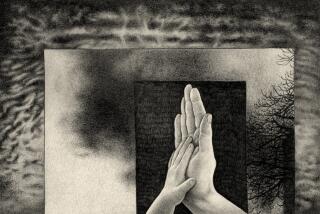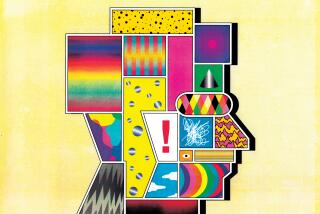Panic-Stricken : Anxiety Attacks Have Afflicted Millions, From Actors to Athletes
NEW YORK — Every day millions of Americans live in dread fear of fear itself.
In their lifetimes, 26 million will be visited by irrational terror, some by a choking, heart-racing, dizzying, paralyzing panic so severe that they think they are dying or going crazy.
For some, it means insulating themselves, locking themselves up in their homes alone, or, paradoxically, making sure that they are always with someone they trust in circumstances they can trust.
Each new attack reinforces the last.
Dr. Jack Gorman and his colleagues at Columbia University’s Department of Psychiatry and the New York State Psychiatric Institute say patients with panic disorder often describe their first panic attack with remarkable vividness. They recall in detail what they were doing on the day of the first attack, what happened, and how they felt afterward.
“Such descriptions convince the clinician that panic attacks are devastating,” Gorman says. “Feelings of dread, fear, and a sense of impending doom overwhelm the patient who becomes lightheaded, dizzy and faint.”
Dr. Alan Goldstein of Philadelphia’s Temple University, says, “At the core of all this is a learned fear of fear.
“Just as someone bitten by a dog comes to fear dogs, so does one bitten by panic come to fear panic. Just as the body mobilizes for an anticipated dog attack with the ‘fight or flight’ response, so it does with anticipated attack from within by panic.”
An estimated 9% of Americans are afflicted with anxiety-phobic disorders in any six-month period, a third more than those suffering from alcohol and drug abuse, and almost a third more than those suffering from depression and related disorders.
Doctors who intervene to break the chain of fear frequently force the patient to face his fear. Dr. David Clark of England’s Oxford University says patients sometimes interpret an increased heart rate as evidence of a heart attack, or breathlessness as a sign they are about to suffocate, or racing thoughts as a sign they are going mad.
He asked one patient who feared that he was going mad if he had ever actually gone mad. The patient said no. Then why not, asked Clark, and the patient said he always mastered his thoughts just in time. Then, if you can do that, said Clark, then certainly you could reverse this skill and make yourself go mad, at which point the patient realized that he couldn’t go mad, even if he wanted to.
Panic disorders are different than--but sometimes lead to--phobias.
But phobias also can cripple a person’s ability to perform, as was the case with the late Sir Laurence Olivier. In at least five years at the close of his career he suffered from stage fright, a phobia that was first documented during his role in “The Master Builder” in 1964. On opening night, the great actor told the audience, “Ladies and gentlemen, I am very sorry, but I am rather ill and. . . . “ His voice trailed off.
While the nature of a phobia is clear to the sufferer, he or she being afraid of going out or crowds or elevators, the trigger of a panic disorder is not. It strikes almost anyone, says Jerilyn Ross of the Anxiety Disorders Assn. of America, including such celebrities as singers Aretha Franklin and Carly Simon and football running back Earl Campbell.
What begins as an innocuous activity, riding in an elevator, getting into a car, sitting at a desk, becomes an absolute horror, lasting up to 10 minutes, sometimes longer.
Campbell, the Football Hall of Famer, recently told a group from Congress how the panic would hit him: “I would just be sitting there, and all of a sudden I would be hit . . . with this unbelievable terror. I could do nothing. I was afraid to move.”
It all came on him after Campbell retired from football and went into business. “I would wake up with my heart racing, breathing real fast, and I would just be afraid to do anything.” By doing research on his problem, he says he’s been able mostly to cure it. “I’ve been lucky.”
Broadway and movie actor Phil Bosco (“Lend Me a Tenor,” “Breaking Legs”) remembers his first visitation with terror when he was a pre-teen, baby-sitting his younger brother who fell off a bed and separated a shoulder. He remembers it as a “night of terrible fear” when he could not quiet his brother’s crying.
But his first real attack probably came when he was 19, driving a truck somewhere around Rahway, N.J. when he encountered a low bridge. “I thought I was dying,” his heart racing, short of breath, filled with “an urge to flee.” He pulled into an illegal lane, and when he got to the other end of the bridge a police car pulled him over. The officer, seeing his plight, let him go.
That led to a fear of bridges. Bosco, now 61, lived with his phobias, which began to include tunnels and elevators. Once he could not make it to a rehearsal for what he recalls was Shakespeare’s “King Henry IV,” and the director led him to psychiatrists who could not really help. Panic disorder was not truly defined until a decade ago.
It was his wife’s interest in medicine that finally led him to psychiatrists who prescribed tricyclical antidepressants. “The last seven years was like a liberation. You begin to fear fear itself.”
At his wife’s urging he has conquered his fears of tunnels, bridges and elevators. “I’m going to work on my fear of flying,” he says.
Willard Scott, the NBC weatherman who also serves on the board of directors of the Anxiety Disorders Assn. of America, says, “The broadcast phobia really hit me one morning just out of the blue. . . . I was on the air . . . and, like that, I started to hyperventilate . . . to the point I was barely able to speak.”
Panic disorder was separated from the rest of human anxieties only about 10 years ago. Panic attacks are sometimes, but not always, associated with some dire life circumstance, loss of a loved or trusted companion, an accident, or a life-threatening illness.
While pregnancy seems to be a shield from panic, panic sometimes occurs shortly after delivery of a child. Some people with thyroid disorders have attacks during stressful situations and many people have their first attacks while using mind-altering drugs, marijuana, cocaine, amphetamines.
None of those preconditions is necessary, however. Some doctors think there is a biological basis for panic and cite genetic susceptibility. Others think of it as a behavioral process gone astray, something which behavioral training can fix.
Summing up recent developments in the field, the National Institutes of Health issued a consensus statement on panic disorder treatment, concluding that a combination of antidepressants and selected psychosocial treatments are effective. It defined the disorder as a cluster of four spontaneous attacks within a four-week period.
It listed 13 discrete symptoms, including shortness of breath, palpitations, trembling or shaking, hot flashes or chills, chest pain or discomfort, numbness or tingling, depersonalization or derealization, nausea or abdominal distress.
Even when critical life circumstances are solved, panic lives on. Gorman cites cases in which patients with thyroid problems can be treated and even after their return to normalcy still fall victim to panic.
Panic attacks, he says, have “a life of their own.”
“After the first panic attack, the patient usually forgets about the incident and anxiety returns to a normal level, without evidence of serious anxiety symptoms. A few days to weeks later, however, a second spontaneous panic attack occurs.”
The same paralyzing set of symptoms.
Usually victims seek emergency medical treatment, and because they report heart or respiratory involvement, doctors order complete medical work-ups. When no problem is found, they are reassured and given broad-ranging common tranquilizers. These drugs are effective in lowering general anxiety, but fail in the face of panic. When attacks continue, patients tend to overdose themselves.
Having failed to find a medical answer, many victims try to go it alone. Some go on for years fighting off several attacks a week. Some turn to alcohol or illegal drugs, in spite of the fact they only mask the situation temporarily and panic rebounds even more strenuously when the initial relief ebbs.
Repeated failure leads to self-diagnosis, which leads to broader phobias.
The utter failure of self-confidence in the face of panic becomes crippling.
Gorman says no one knows why, but about a third of the patients with panic disorders go on to develop agoraphobia, a fear of public places, and others do not. Some associate what they were doing or where they were at the time of the attack as the trigger for the attack.
“For example, a patient who experiences the first few panic attacks while driving a car may believe that avoiding driving will reduce the frequency of panic attacks. Second, and perhaps of greater significance, the patient begins to avoid situations where egress is difficult and help is not immediately at hand.”
The list is long. Subways, buses, airplanes, cars that can get stuck in traffic jams on bridges, crowds in a public theater, elevators.
Although the onset of panic disorders most frequently occurs in teen-agers and young adults, doctors doubt that it is responsible for the high suicide rate in those years.
Depression remains the prime psychiatric disorder preceding suicide attempts, especially among young people, says Dr. Susan Blumenthal, chief of behavioral medicine for the National Institute of Mental Health. Doctors can do much to catch impending suicides, she says, since about half the people who commit suicide have seen a physician in the few weeks to a month before they take their lives.
When doctors become aware that their patients are suffering from panic disorders, they have some potent weapons at hand. Two classes of antidepressants are especially effective, tricyclics and monamine oxidase inhibitors and high-potency benzodiazepines.
But in a study of 43 patients with panic disorder, Dr. William Coryell of the University of Iowa School of Medicine found that one in four given only placebos, rather than drugs, markedly improved, hinting at least that a sizable portion of the problem is in the head.
In the long term, some therapists believe that behavioral training can clear up the concomitant phobias. Patients are encouraged to approach the terrorizing agent, such as the elevator door for instance, one step at a time, then to ride for a few floors, building confidence with each progression. Others suggest psychotherapy.
There are a variety of self-help programs, perhaps the broadest-based being the Anxiety Disorders Assn. of America, formerly the Phobia Society of America. “Amazingly, phobias, the most common of all psychiatric disorders--so long one of the most misunderstood--turn out to be one of the most treatable,” says Ross, the head of the association. “Yet, sadly, thousands of people still have not been helped because they have been unable to find and/or afford effective treatment, or are too frightened or embarrassed to ask for help.”
Her organization tries to connect people with phobias with each other and with professionals to get them to confront their fears and their isolation. It has established some 300 groups around the country.
Freedom From Fear is another self-help organization, connected with New York’s Columbia University. Its founder, Mary Guardino, is a former phobic. She finally turned to treatment one day when she had to interrupt a car trip to a mall with her three children.
“I couldn’t tell them we can’t go to the mall, your mother is having a panic attack,” she says.
More to Read
Sign up for Essential California
The most important California stories and recommendations in your inbox every morning.
You may occasionally receive promotional content from the Los Angeles Times.










